Main technical innovations of Songke Well No.2 Drilling Project
Yong-yi Zhu, Wen-shi Wng, Xio-ming Wu, Heng-chun Zhng, Jie Xu, , Ji Yn, Long-long Co,Heng-qin Rn, Jin-chng Zhng,*
a Institute of Exploration Techniques, China Geological Survey, Langfang 065000, China
b China University of Geosciences (Wuhan), Wuhan 430074, China
ABSTRACT
Songke Well No.2, one of the main part of the scientific drilling project in Songliao Basin, which was drilled 7018 m and acquired the part of cores continuously from the Low Cretaceous to the Carboniferous and the Permian from the 2843 m deep, can be considered as the deepest continental drilling project in Asia. Aiming at the features of longer well sections, larger diameters and multiple spud-ins for coring of Songke Well No.2, this project broke through the “coring in small diameter and reaming in large diameter” spud-in drilling-completion procedures which are always used in large-diameter-well coring for continental scientific drilling projects in domestic and overseas and the drilling method of short-singlecylinder roundtrip footage. At the same time, “coring in the same diameter and completing drilling at one single diameter” was achieved at all φ311 mm and φ216 mm coring sections of more than one thousand meters long, high-efficient operation with “drilling long footage with drill tools combined in multicylinders” was achieved at deep coring section. Four world drilling records were created which include more than a thousand meters continuous coring at φ311 mm, and the footage per roundtrip footage at φ311 mm, φ216 mm and φ152 mm is all more than 30 m, all of these breakthroughs reduced at least 300 days for this project; moreover, considering the characteristics of formations that the geothermal gradient is high in the drilled sections and the inside-well temperature is over 240°C after drilling completion, a formate-polymer water-based mud system was developed by compounding attapulgite and sodium bentonite and by adding independently developed high-temperature stabilizer, which can provide critical technical support for successful well completion at 7018 m in the super-high-temperature environment It is the first time that the water-based mud is operated at the working temperature higher than 240°C in China;Besides, considering the high-quality requirement on cores imposed by the project, the method“mechanical cored is charge” to discharge core nondestructively on the ground was worked out, and more than 4000 m scatheless cores were discharged out of the drill pipes while maintaining original stratum structures.
Keywords:
Songke Well No.2
Long drilling process
Large diameter
Super-high-temperature water-based mud
Nondestructive core discharge
1. Introduction
In addition to one of main projects of the scientific drilling project for Songliao Basin in China, scientific drilling Well No.2 in Songliao Basin (Songke Well No.2), is the third ICDP framework project funded by International Continental Drilling Program (ICDP), followed by the scientific drilling projects in Dabie-Sulu ultrahigh-pressure metamorphic zone and environmental scientific drilling projects in Qinghai Lake.In 2013, in order to achieve four main goals – exploring the energy potential in the deep Songliao Basin, establishing the strata’s structural profile in the deep Songliao Basin, looking for geological evidence on climate change in the Cretaceous,and researching and developing technologies to explore the deep Earth, China Geological Survey (CGS) approved to launch Songke Well No.2 as a comprehensive geologic research and drilling project, and appointed CGS’s Institute of Exploration Techniques (IET) to organize and implement the drilling project.
Continuous cores from Songke Well2, should be operated from Section 2 (the well depth: 2865 m) of the Cretaceous Denglouku Formation in the basin to the basement of the lake basin and cross part of Carboniferous and Permian strata. The core diameter is at least φ95 mm and the coring recovery rate is at least 95%. By analyzing the objective conditions and current technical status in drilling and exploration, the following four aspects will challenge and constrain the Songke Well No.2 with respect to drilling techniques and drilling efficiency: (1) based on the stratum distribution of construction area, the wellbore structure is designed to five spud-ins and coring will be operated at the 3rdto 5thand the diameter will be 311 mm, 216 mm and 152 mm respectively;(2) continuous coring for more than 4000 m footage starting with 2865 m necessarily requires lots of auxiliary time for drilling tools to go up and down; (3) since the well is located in the anomalous geothermal gradient zone where the temperature increases more than 3.5°C every 100 m deeper, it can be predicted that the circulating temperature inside the well will be above 235 °C upon drilling completion, and the recovered well temperature may be higher than 250 °C; (4)When cores are lifted to the ground with the drilling tool, the traditional core discharge method that using strong shock to get cores out may not be used in order to maintain the stratigraphic original structure that present in cores.Therefore, the main technical innovation solutions for Songke Well No.2 are determined to be: develop the large-diameter diamond core drilling and long-roundtrip process core drilling technologies to improve the overall drilling efficiency for the large-diameter coring sections; develop a mud system resistant to the ultra-high temperature up to 260 °C, to ensure finish drilling successfully; develop new discharge technology to maintain original structure of the cores.
The drilling rig was set for Songke Well No.2 on March 15, 2014, the drilling began on Apr. 13, 2014 and completed at the depth of 7018 m on Mar. 17, 2018, and the well was completed on May 16 which became a deepest continental scientific exploratory well not only in Asia but also since the founding of ICDP that 22 years ago. The site operation took 1523 d. There are 1147 effective working days in total after deducting 376 calendar days for organized shut-down due to project management systems and related technical tests.Under the guidance of the established goals, a few technical innovations and indexes for drilling techniques were broken through in this project, which create several domestic drilling records including the cement wall building at the well temperature of 200°C and the well cementation and logging at the temperature 241°C. This paper will introduce the most important four innovative outcomes about drilling techniques.
2. Geological background and wellbore structure
2.1. Songliao Basin scientific drilling project
Songliao Basin Scientific Drilling Project planned to drill two wells and four bore-holes, and to get core of ten thousand meters deployed in Daqing-Anda region, Heilongjiang, China.Songke Well No.1, consisting of the south bore-hole and the north bore-hole, is mainly intended to acquire cores from the Tertiary Taikang Formation to the Section 2 of the Cretaceous Quantou Formation. Songke Well No.2, consisting of the west bore-hole and the east bore-hole, is mainly intended to acquire cores from the Section 3 of Quantou Formation to the basement of the lake basin till the Carboniferous and the Permian (Fig. 1, Fig. 2) (Qu XJ 2015; Wang PJ et al., 2017).The data from approximately 10000 m deep cores of four bore-holes can be combined to constitute the first determined continental Cretaceous integrated profile in the world (Wang ZH et al., 2011). So far, all bore-holes are completed except the west one (Table 1). Unless specifically marked, Songke Well 2 in the rest part of this paper means the east bore-hole.
2.2. Stratigraphic distribution
The stratigraphic distribution of Songke Well No.2 is shown geologically in Table 2. The drilling is designed to complete at the depth 6400 m and the well extends into the Carboniferous and the Permian for 160 m.
2.3. Wellbore Structure
Based on the stratigraphic distribution indicated by Table 2,the design of wellbore structure of Songke Well No.2 is shown below:
(1) Well head: setting the φ720 mm pipe into 20 m underground to segregate the wellbore from the overlying loose stratum to establish the circulation of drilling fluid.
(2) The 1st spud-in: the stratum was collapsing and rock falling occurred seriously during actual drilling due to the extremely unstable Late Cretaceous Sifangtai Formation. To ensure the safe and fast drilling of the lower stratum, drill down 450 m with the φ660.4 mm 1st spud-in bit entering Mingshui Formation about 15 m, and then set a 508 mmdiameter casing to segregate it from the loose stratum in Sifangtai Formation and above.
(3) The 2nd spud-in: drill down 2840 m with the φ444.5 mm bit, and then set the φ339.7 mm casing segregate the wellbore from complex zones of Section III of Denglouku Formation and Qingshankou Formation to create safe conditions for continuous coring sections.
(4) The 3rd spud-in: drill down 4500 m with the φ311 mm coring bit, and then set φ244.5 mm casing to segregate the wellbore from the Shahezi Formation and the water-sensitive muddy rock strata with frequently distributed thin seam above Shahezi Formation.
(5) The 4th spud-in: drill down 5800 m with the φ216 mm coring bit and then set the φ177.8 mm casing to segregate the wellbore from the water-sensitive mudstone in Shahezi Formation, so as to create conditions required by the 5th spudin to enter the basement of the lake basin by drilling through the Jurassic strata safely.
(6) The 5th spud-in: drill down 6400 m with the φ152 mm coring bit until drilling is finished, and then set the φ127 mm tail pipe with special collar to complete the well drilling.
The wellbore structure is designed as shown in Fig. 3a.When it was drilled to the designed completion depth in October 2018, based on new geological findings, CGS adjusted the completion depth to 7018 m. The actual completed wellbore structure is shown in Fig. 3b.
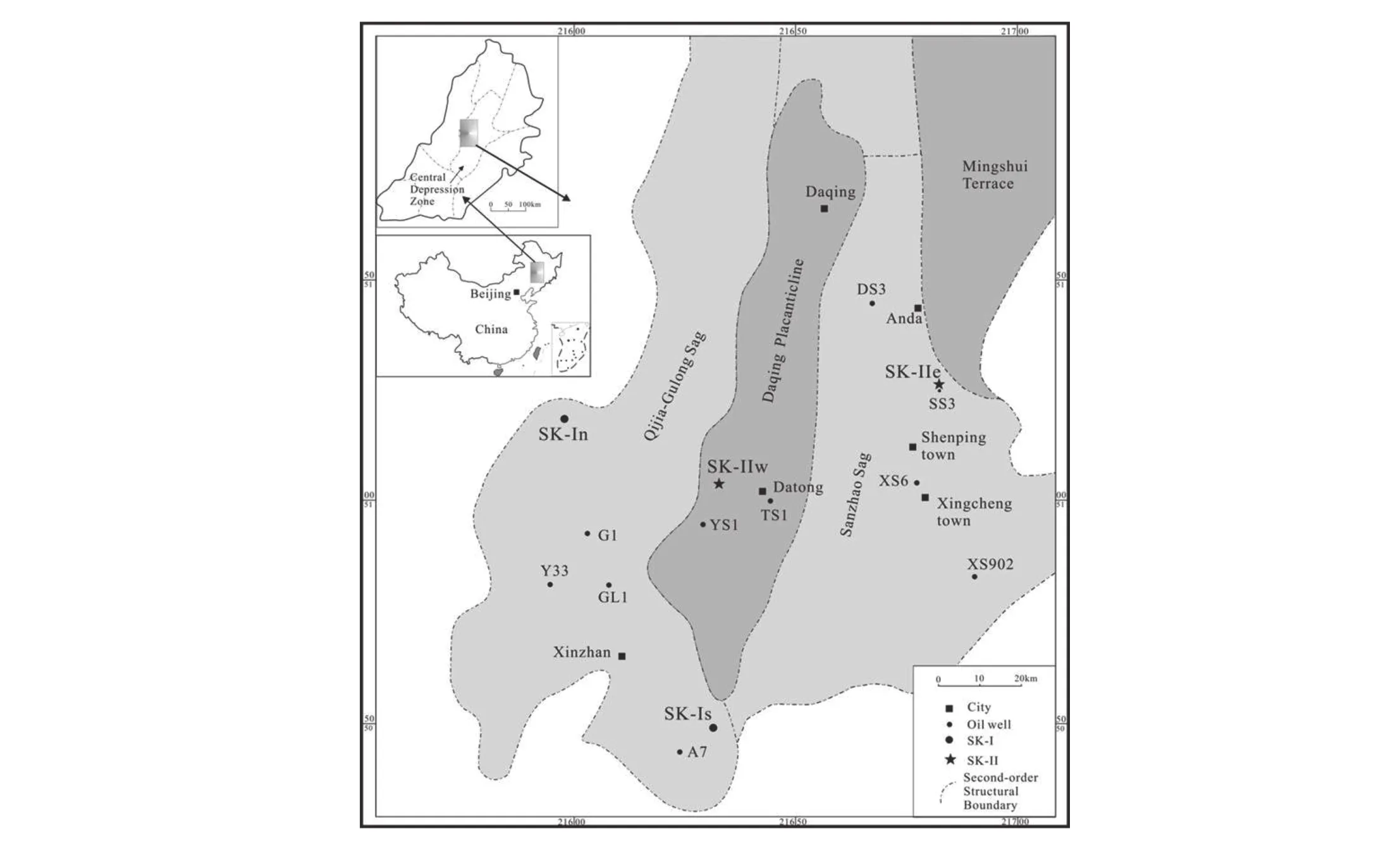
Fig. 1. Base map of "two wells and four holes" locations during the scientific drilling in Songliao Basin.
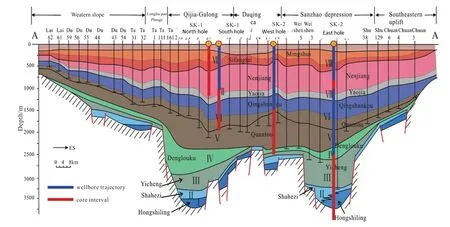
Fig. 2. Cross section of the well positions in Songliao Basin.
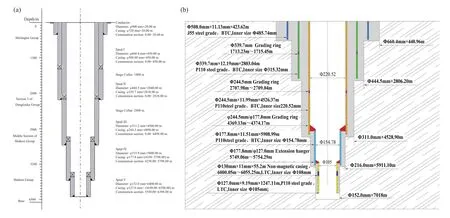
Fig. 3. (a) The original design of the borehole structure of CCSD-SKII. (b) Borehole structure of well completion of SK-II.
3. Innovations and breakthroughs in drilling technologies
3.1. Large Diameter Diamond Coring in the Same Diameter
3.1.1. Current Technical situation
When Cola ultra-deep well (Cola Well 3) was drilled in former Soviet Union, due to the uncertainties in stratigraphic factors, the well sections below the 1st spud-in were not designed in detail for the wellbore structure; on the contrary,the operational procedures were: after the 1st spud-in, theφ216 mm bit was drilled for coring, and when encounteringany complex in the well, it was reamed from above and casing was set to segregate it from the complex stratum, known as"earlier open-well core drilling" (Kozlowski EA, 1989) (e.g."Coring in a small diameter and reaming in large diameter").The 2nd squd-inφ216 mm bit of Cola Well 3 stopped drilling until drilled at 5400 m because of wall collapsed at the depth of 1800 m, it was reamed below 2000 m and cemented withφ324 mm casing. During the 3rd spud-in, theφ216 mm bit was still used to drill, but when an irremediable accident happened at 12000 m, it was reamed again from the depth 2000 m to 8700 m, and then was cemented by setting downφ245 mm casings. After that, it was sidetracked at the depth 7000 m to bypass the downhole obstacle, and finally theφ216 mm bit was drilled down at 12262 m and the well drilling ended (Liu DH et al., 1998). Though the spud-in drilling completion procedure was initially used to deal with unpredictable strata, after Cola Well3, any core-oriented scientific drilling at home and abroad would follow the drilling completion procedure for the coring section of the mid spud-ins, even if a wellbore structure is clearly designed for the whole well (Table 3). For example, CCSD Well1(Wang D et al., 2007), and a series bore-holes to explore Wenchuan Earthquake fault zone (Jia J et al., 2012; Zhu HY et al., 2012) in China are followed this drilling completion procedure. Furthermore, during drilling of volcanoes in Hawaii, USA, even bits of two diameters were used at all costs so that the hole drilled with theφ98 mm bit was reamed to theφ311 mm and then to theφ445 mm until completion(Zhang W, 1999).

Table 1. Completion of scientific drilling program in Songliao Basin.
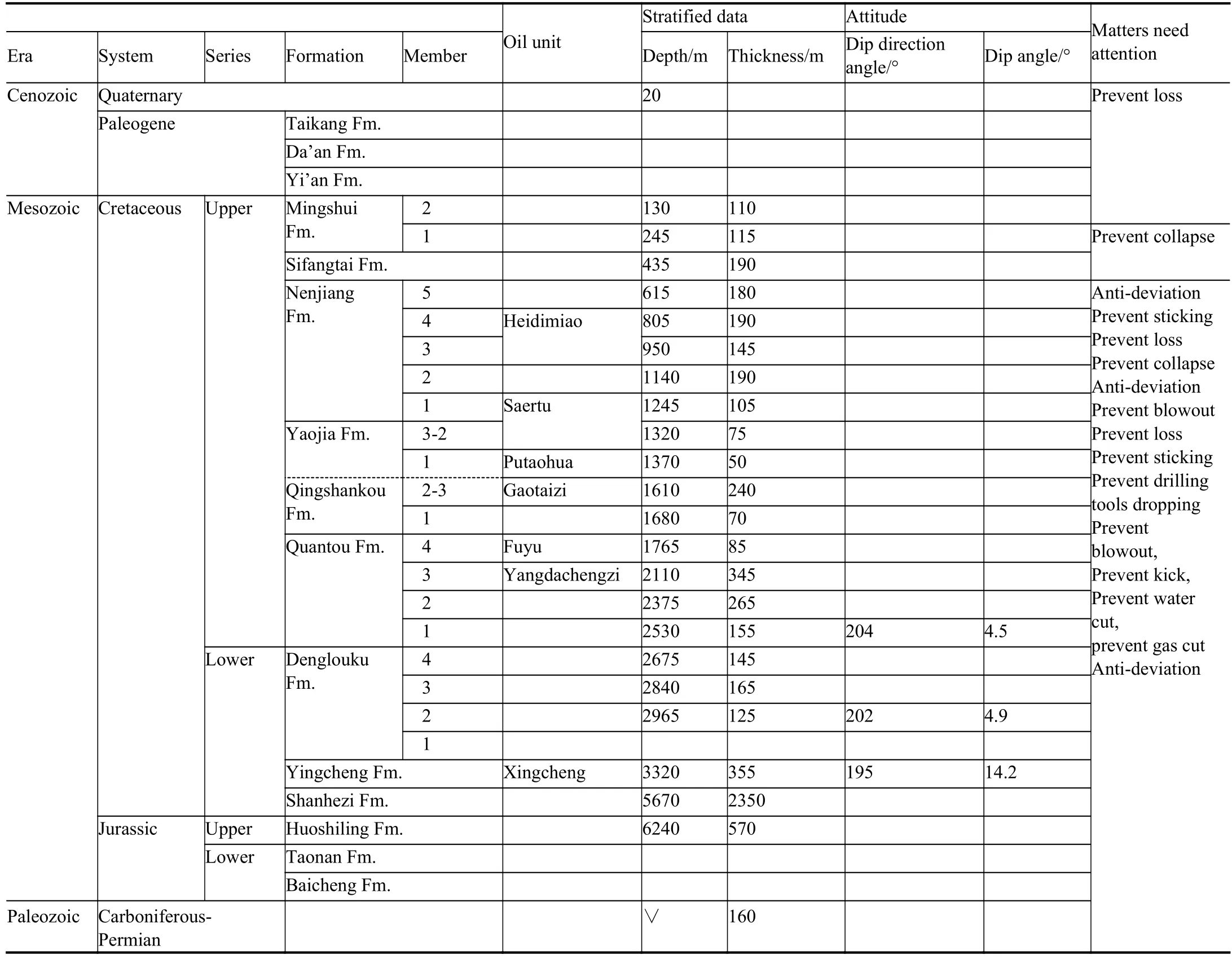
Table 2. Stratigraphic column of Songke Well No.2.
All wells in a series drilling plans of former Soviet Union and the KTB project in Germany were drilled through hard metamorphic rocks. Possibly because the technologies to manufacture large-diameter diamond bits were not well developed, and the roller bit had longer life and offered higher drilling efficiency. Theφ216 mm hollow roller bit was used to drill all wells in the form of early coring in Soviet Union, and the cores were 60 mm and 80 mm in diameter respectively(Kozlowski EA, 1989). For the well sections that the diameter of KTB pilot holes and main holes are equal to or above 216 mm, and the hollow roller bit of the same diameter was mostly used to drill for coring (Engeser B et al., 1996). The coring recovery rate from the roller bit is commonly very low(Table 4); Moreover, cores are rough in appearance and the stratigraphic original structure is damaged (Fig. 4), therefore,it is hard to meet the requirement of precise and high-level geological research. With the development of artificial diamond production techniques and diamond bit manufacturing technology, the experiment about diamond same-diameter coring on theφ311 mm well section for KTB main holes was successful in some way. Since the ratio of the cored length and the whole drilled length was below 5% for this drill hole, this method was just used 8 times and had drilled 21.50 m. the coring recovery rate was a little higher than that of the roller bit coring, which still did not exceed 75% (Engeser B et al., 1996).
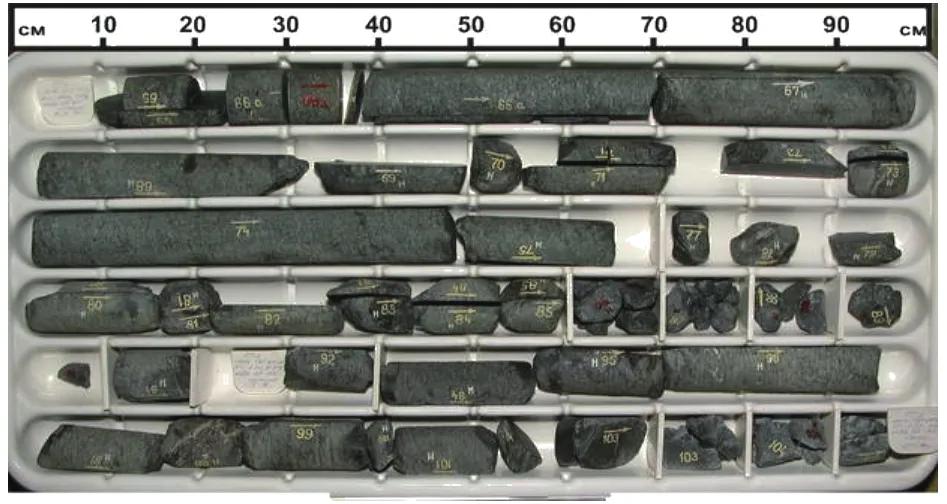
Fig. 4. The cores drilled by rock bit in Kola-III.
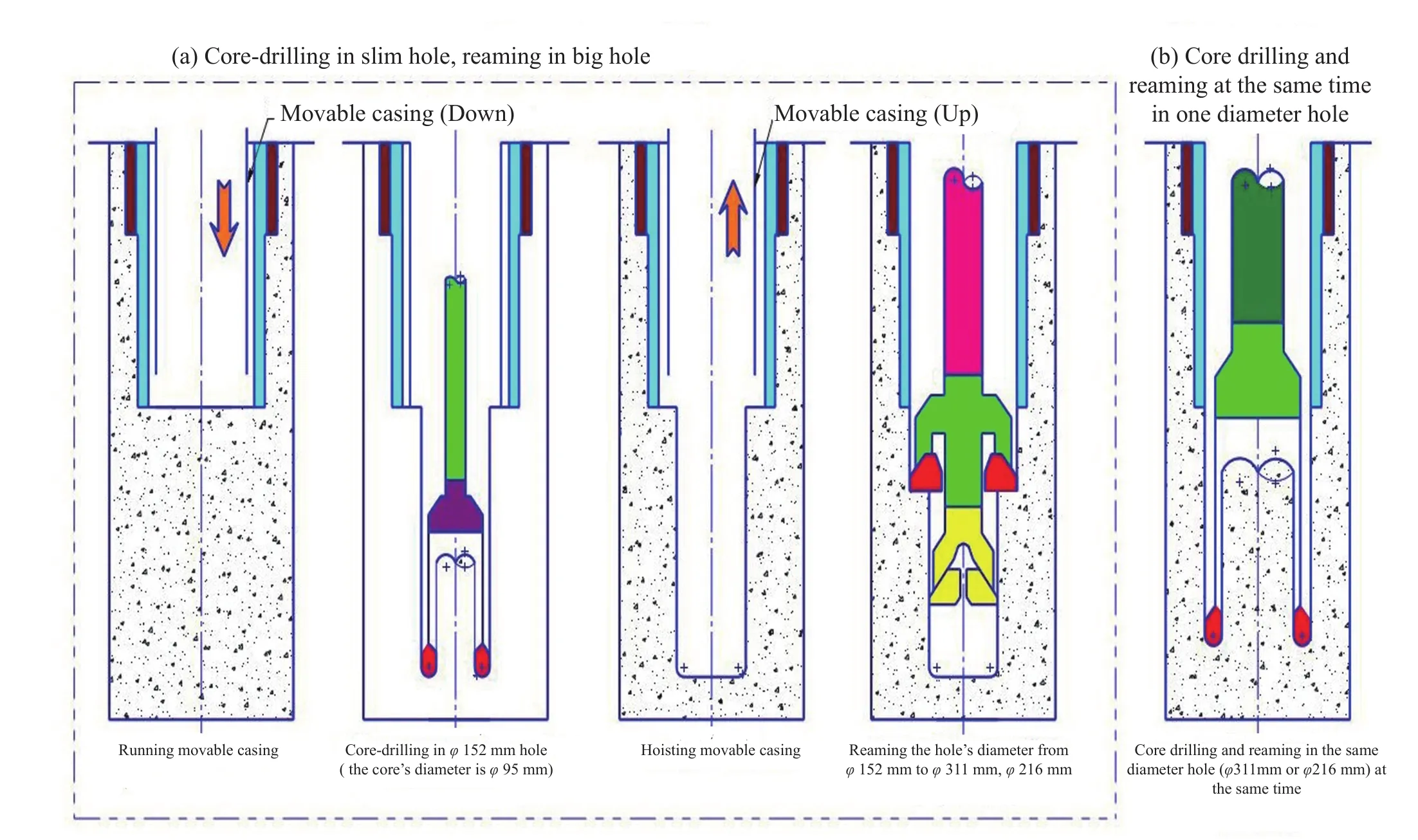
Fig. 5. Steps of two different core-drilling methods in large diameter interval.

Fig. 6. (a), (b) Seventy-two reeds from the coadjutors failed into CCSD-1 while hoisting movable casing. (c), (d) The guiding part of pilot bit failed into CCSD-1. (e) KT-type drilling tools.

Table 3. Stratigraphic column of Songke Well No.2.

Table 4. Large-diameter coring of SG-3 and KTB project.
Theφ216 mm coring is a well-developed technology in the petroleum drilling. It is possibly because of differentdesign concept, the drilling tools used in theφ216 mm wells the drill bit is 55.5 mm in wall thickness, 105 mm in diameter maximally (Chuan Type 8-4) and the crushed rock area on the drill bit is up to 279.85 cm2. Since the drilling efficiency of the bit is inversely proportional to the crushed rock area of the bit, with all working conditions are provided, an important design principle to improve the drill bit efficiency is to increase the inner diameter of drill bit to decrease the crushed rock area. According to synthesize the safety analysis on specifications of petroleum pipes and “l(fā)ong-roundtrip process drilling” (see 3.2 section), there is space to optimize the dimensions of the drill bits.
3.1.2. Technical thought
The mid-spud-in "coring in small diameter and reaming in large diameter" drilling completion procedure needs to go through four operational steps (Fig. 5a): set down moving casing, pre-core in small diameter, lift the moving casing and ream in large diameter for drilling completion. Although it is helpful to deal with uncertainties of stratum, there are a number of pitfalls for this procedure during actual operation:multi-step operations have been consumed lots of time (Table 3);falling is prone to happen in the well (Fig. 6a, b, c, d); The drilling torque for reaming fluctuates greatly which is prone to lead to downhole accident. Considering that it is tedious,time-consuming, high technical risk and expensive drilling cost, the team for Songke Well 2 proposed a technical idea that applying the diamond coring method of “core in the same diameter and complete drilling in one diameter” in the largediameter coring section continuously (Fig. 5b), which can reduce the operational period and cost for the 3rd and 4th spud-ins of Songke Well 2 (Fig. 3b) and avoid the risk from reaming. It is more valuable that this method allows to get cores of which the quality is higher than that from the rollerbit coring in the same diameter, and to get more cores in the same amount of footage compared with the small-diameter diamond coring.
3.1.3. Engineering application and technical outcomes
A series of KT large-diameter drill tools that developed by IET is shown in Fig. 6e. This figure shows KT-152, KT-216,KT-311A (φ198 mm cores) and KT-311(φ214 mm core) from top to bottom respectively. According to API standards on petroleum pipes, force-bearing conditions of drilling tools and downhole safety checking, the technical parameters of two drilling tools KT-311 and KT-216 used for Songke Well No.2 are determined as shown in Table 5. Both drilling tools are successfully applied in the sections of the 3rd and 4th spudins of Songke Well No.2 (Table 6, Fig. 7), where the footageis 1679 m and the coring recovery rate is 98.02% for KT-311,the footage is and the coring recovery rate is 93.22% for KT-216.
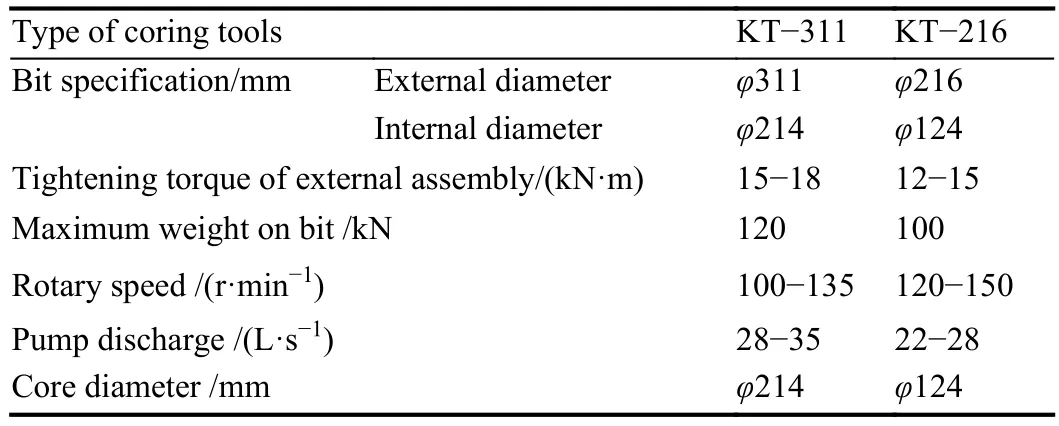
Table 5. Technical parameters of large diameter KT coring tools.
In theφ311 mm andφ216 mm deep well sections, world records that drilled continuously with the diamond bit in the same diameter more than 1000 m core were created respectively, in which also resulted in high-quality coring outcomes (Fig. 7). Especially for the success in theφ311 mm same-diameter continuous coring, caught lots of attentions from the international community of continental drilling and exploration, and the related report was post in the center of the ICDP official website homepage (Fig. 8).

Fig. 7. Cores drilled by large-diameter drilling tools in the equal borehole. (a) φ214 mm cores drilled from the Spud III of CCSD-SKII.(b) φ124 mm cores drilled from the Spud IV of CCSD-SKI.
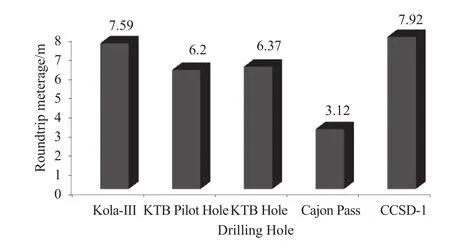
Fig. 8. The average roundtrip meterage in different scientific drilling projects. The KTB's data is based on core-drilling by rock bit, and CCSD-1 data is based on hydro-percussive tools.
(2) Due to scientific drilling projects requiring large-diameter continuous coring in long well sections, the “coring in the same diameter” method totally avoids multiple steps of“coring in small diameter, reaming for drill completion” and averts downhole risks potentially present in the long section reaming and regular reaming, then the first “drilling completion in one diameter” international project was created.Compared with continental drilling projects in China and abroad that complete drilling by reaming (Table 3), applying the method in Songke Well No.2 reduced the workloads of 1720 m and 1380 m reaming lengths for φ311 mm/φ152 mm and φ216 mm/φ152 mm respectively (Fig. 3b). Estimated on the basis of previous experience in reaming operation, the method “drilling completion in one diameter” reduced the operational period at least by 120 d for Songke Well No.2 even if there is no downhole accident happening during operation.

Table 6. Technical indicators of large diameter core drilling.
(3) Compared with the hollow roller-bit coring method used abroad, the method of large-diameter diamond coring improves the coring recovery rate more than 50% (Table 4, 6)and cores change fundamentally in terms of quality (Fig. 4,Fig. 7), thus, it can provide more precise physical material data of deep strata for geoscientific research. The successful application of this method in Songke Well 2 will set a positive example for both continuous and discontinuous coring in the large-diameter well sections for future scientific drilling projects.
(4) The diameters of cores drilled byKT-311 and KT-216 are214 mm and 124 mm respectively, which are respectively 5.07 times and 1.70 times than that of the lower limit of the core diameter (φ95 mm) required for Songke Well No. 2. The core drilled by KT-216 is 19 mm larger than those drilled by other drilling tools in the same sizes used for domestic petroleum drilling (Chuan Type 8-4). The crushed rock area on the bit decreases by 12%, which not only increases the yield of core but also improves the drilling speed, therefore, it is suitable for hard stratum and can be used in multiplepurpose drilling projects.
3.2. Long-Roundtrip Process Core Drilling
3.2.1. Current status of roundtrip process in scientific drilling and coring
Coring roundtrip process (CRP) refers to the footage drilled by the coring drill tool every time, also called roundtrip footage. Fig. 8 shows the mean CRPs of a few notable scientific drilling projects (Kozlowski EA, 1989;Zhang JC and Xie WW, 2010; Wang D et al., 2007), which indicates that the maximal mean CRPs is never more than 8 m through these scientific drilling projects. In these projects,hollow roller bits were used in all of Cola Well 3 and main holes of KTB, while diamond bits were used in the rest projects. For CCSD Well 1, due to the brittle rocks that are also easy to block the well, the mean CRP from rotary drilling alone was only 2.18 m (Wang D et al., 2007). Only after the hydro-hammer technique is well developed and applied,effective measures could be taken to remove core blocking,leading to significant increase in CRP and mechanical drilling speed. The roller bit produces relatively crushed cores at a very low coring recovery rate (Table 4), and most of cores are crushed and flushed away during drilling. A small volume of cores enters the drill tool, so the possibility of core blocking becomes less and therefore the roundtrip footage rises accordingly. However, this method to raise the roundtrip footage at the cost of core is obviously not a good drilling method because it fails to meet the needs of more high-end,more precise geo-scientific research.

Fig. 9. KT type core-drilling tools assembled by three long core barrels.
3.2.2. Combine drilling tools into multiple cylinders to increase CRP
It is unnecessary to specify that how CRP (also known as roundtrip footage) influence the overall drilling efficiency of core drilling, especially for deep wells. Improving the roundtrip footage from core drilling can be always considered as an important research fields focused by the core drilling researchers.
Making coring drilling tools with larger storage spaces that can be considered as an essential condition to increase CRP. Fig. 9 represents the drilling tool for coring in Songke Well No.2 which is invented the basis of single-cylinder drilling tool KT that has been well developed and applied in scientific drilling projects in China (Zhu YY, 2006), it is installed with three inner and outer tubes, which is capable of containing 31 m core (for the purpose of rigorous definition, a tube refers to pipes distributed over the section, for instance,liner tube, inner tube and outer tube; a cylinder refers to pipes distributed axially, for instance, upper cylinder, mid cylinder and lower cylinder). Based on the downhole conditions, the drilling tool may be assembled in the form of one, two and even four cylinders. However, it is required that, when designing the drilling tools, the designer must not only assure that the lengths of the combined inner and outer tubes shall fit the requirement but also ensure the lengths of all inner tubes as well as all outer tubes are consistent so as to avoid using too many pipes at the site or chaos due to multi farious pipe dimensions, helping assemble drill tools quickly on the site.
3.2.3. Indexes to assess the CRP benefit
For core drilling, the drill-tool going up/down operations take most of the auxiliary working time; with the deeper depth of the well, the drill-tool takes longer to go up/down. For instance, the Songke Well No.2, which is drilled with a ZJ90DBS drill rig, takes about 24 h in the well depth of 5000 m and 30 h in the well depth of 6000 m for the drilling tool to go up/down once, therefore, the drilling benefit of a CRP correlates greatly with well depth. It is noticed that increasing CRP not only results in increased pure-drilling time, but a variety of works would spend additional auxiliary time, for instance, assembling multi-cylinder drilling tool and putting it in/out of the well, connecting a single drill pipe after the drive stem finishes drilling to extend drilling, many core-blocking problems during long process drilling. In order to evaluate the drilling benefit of CRP more accurately, it is necessary to create the concept of the roundtrip meter drill hours at different depths of well sections (roundtrip meter drill hour or RMDH).
The total roundtrip hours (TRH) refers to the time interval from the start of assembling the drill tool for the current roundtrip to the start of assembling the drill tool for the next roundtrip. The TRH works include assembling drill tools,moving it up /down the platform, driving it to go up/down,purely drilling, other auxiliary works, as well as faults and stoppage. In these works, faults and stoppage are not artificially controllable. To unify the standard for comparison,the roundtrip working hours excluding the hours for faults and stoppage is called Roundtrip Drill Hours (RDH), then RMDH=RDH/roundtrip footage (in h/m). Obviously, in the case of the same depth, the smaller the RMDH, the more significant the drilling benefits. With this index, it is easy to reckon the contribution of CRP to the drilling benefit of the entire well.Omitting the calculation process, Fig. 10 shows the RMDHs comparisons in different drill processes and in different depths from 4000 m to 6000 m of Songke Well No.2. This figure illustrates that in the well depths of 4000 m, 5000 m and 6000 m, the three-cylinder 30 m drilling process spends RMDH shorter than the one-cylinder 10 m drilling process by 1.40, 1.71 and 2.10 drilling hours respectively, which indicate the large impact of CRP on deep well drilling.
3.2.4. Engineering application and technical outcomes
For Songke Well No.2, the dual-cylinder drilling was attempted from the depth of 3000 m and it succeeded. Since the key technologies had been conquered, for instance, the technology of combining multi-cylinders into the drill tool,connecting an additional drill stem during drilling, removing core blocking, moving ultra-long drill tool up/down the platform and move in/out of the well, the three-cylinder and even four-cylinder drilling was applied in operation. In theφ311 mm,φ216 mm andφ152 mm well sections, the world records of single roundtrip footage were created which were 30.60 m, 41.69 m and 33.91 m respectively (Table 7), RMDH was reduced dramatically in the deep well section (Table 8),and this result of Songke Well 2 was published on the ICDP official website (Fig. 11). According to Table 8 and Fig. 10, it is not difficult to calculate roughly that the long-process core drilling shortened the construction duration of Songke Well No.2 by at least 180 d.
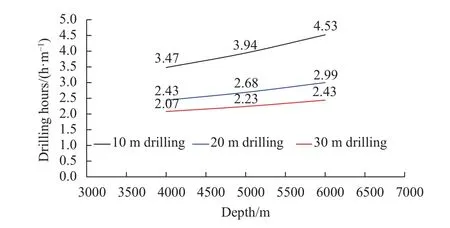
Fig. 10. The comparison of the efficiencies on three different lengths of cores drilled in a single roundtrip, 10 m, 20 m, 30 m.
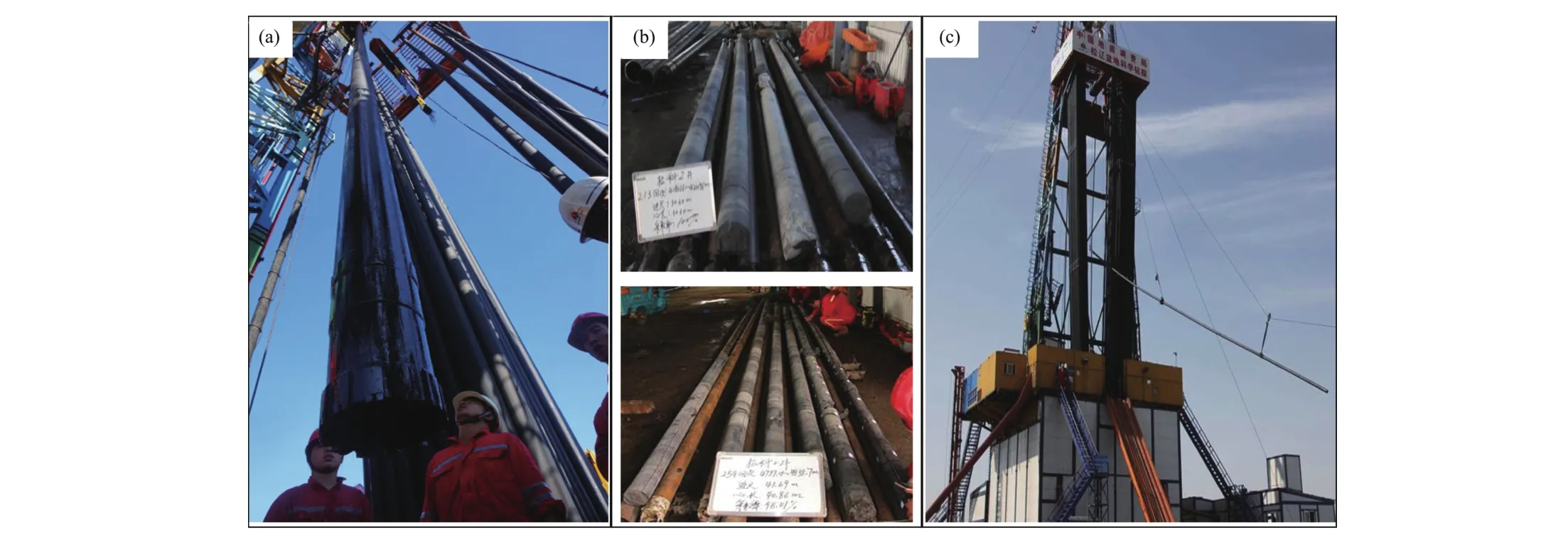
Fig. 11. The extended core drilling tools and core samples (a) The moment of three core barrels drilling tool lifted up from the borehole. (b)Cores. (c) The extended core-drilling platform.

Table 7. Longest record of round trip meterage in each spud.

Table 8. Influence of roundtrip meterage on penetration rate.
3.3. Ultrahigh-temperature water-based mud system
3.3.1. Current technology situation
Based on the components of continuous-phase materials contained in mud, mud can be divided into three categories that include water-based, oil-based and synthetic based. Oilbased mud is good at lubrication, being resistant both to high temperature and salt and calcium erosions, and favorable to wall stability and less harm to hydrocarbon reservoirs,however, it is expensive, and may cause some pollution to the environment and related safety problems. It should be applied under certain restrictions; water-based mud will not harm the environment as long as any illegal treating agent which is not used, and waste slurry is treated in accordance with environmental-protection rules. Water based mud is widely used in various drilling projects. Although water-based mud is not expensive to compound, it is technically the most difficult to maintain its performances in the extreme stratum conditions(e.g. high temperature, high salt content); synthetic-based mud can be considered as a new mud system having characteristics of oil-based mud in terms of performance and featured environmental protection, it is also the system with the highest mud-making cost which is not widely applied due to limited sources of raw materials (Wang ZH, 2011).
At present, internationally, the petroleum well with the highest temperature is Rossa Well 1 in USA, which is 7265 m deep and up to 290°C in the downhole The well starts from 3048 m using the oil-based mud at density 1.34 g/cm3which was gradually increased to 2.23 g/cm3(Huang LJ, 2011); the second one is Garden Bank Block Well 386 in USA, which is 8493 m deep and up to 275°C in the downhole, and a synthetic-based mud is used (Prater T, 1999). In Louisiana water area, water-based mud was used to drill a 7803 m ultradeep well, of which the downhole temperature is 260°C and below 7000 m the 2.32 g/cm3ligno-sulfonate oil-emulsion drilling fluid was used (Wang ZH, 2011). TSD/TSF polymer mud that has been successfully applied in Mobile Bay still remains good thermal stability and inhibitive ability at the downhole temperature 232°C (Thaemlitz CJ et al., 1999). The Duratuerm system, developed by MI, which is resistant to 260°C in the lab conditions, was successfully used in a USA well with the highest temperature 236°C, and in Zistersdorf,Austria (Xu TT, 1991). The EHT system, developed by EXXON, has been applied at the downhole temperature up to 215.5°C in the density of 1.86 g/cm3(Elward-Beeey J et al.,1997). Japanese researchers used two materials resistant to high temperature, G-500S and therma V, as main component,to have prepared a mud which was used to drill two wells in the Mishima Base and Hsinchu Nocho. The depth and downhole temperature are 6310 m and 205°C respectively(Konno M, 1993; Morihiro S, 1994).
In China, the well with the highest temperature is Mishen Well 1 that is 6005 m deep and 236°C in the downhole (Sun ZW et al., 2009). Polysulfonate mud system was used for this well. After the formula is at 245°C, its viscosity and shearing force become smaller, both filtration and frictional resistance will rise, but it is still capable of meeting the drilling requirements. The second one is Shengke Well 1 which is 7026 m deep and 235 °C in the downhole, and the hightemperature polysulfonate mud system is also used in the section between 5800 m and 7026 m (Li GR et al., 2009). In China, the indoor water-based mud is able to resist the temperature of 260 °C as maximum, which is developed by Zhongyuan Oilfield, but it has not been applied in the ultrahigh-temperature well sections in the field.
3.3.2. Technical Challenges
(1) High-temperature challenge: high temperature will cause mud to lose its good rheological property, deteriorate mud cake and raise the filter loss. The sub-micron particles in mud is in high content and strongly dispersive and will make mud thicken or harden at the high temperature; Moreover,high temperature will lower the PH value of mud, which can incapacitate the mud treating agent to work fully and perform poorly. If mud stops circulating and is left in the hightemperature downhole for a long period, its stability is severely challenged.
(2) Wall stability: some stratums are prone to cave in which are possibly resulting in rock falling, it is very important to take measures to prevent such cave-in. Songke Well No.2 also poses severe challenges to the ability of mud to protect the wall after it is drilled below 2840 m because of drilling and coring throughout the well, frequently moving up and down the drill tool, longer open hole, longer construction period and the wall being soaked longer. Additionally, high temperature may affect long open holes. Mud flowing up may heat the upper open-hole sections, while the temperature difference between mud and stratum will lead the porous pressure and the effective stress near the well to change,causing the upper part to collapse and the rock to fall (Li GR et al., 2009).
(3) The circulating flow for the core drilling is small,mudflows up at a slow speed, the temperature drop from circulation is small, and it will suffer more severe due to ultrahigh temperature.
3.3.3. Technical route
(1) Drilling fluid systems for every spud-in are designed on the basis of the predicted geothermal gradient in the geological design, and the geothermal gradient measured in the current spud-in is used to determine the temperatureresistant index for the ensuing spud-in. After the 3rd spud-in,the actual temperature-resistant index in the high-temperature sections is: 180°C in the section 4600 m to 5200 m and 210 °C in the section 5200 m to 5900 m during the 4th spud-in;230°C in the section 5900 m to 6400 m and 250°C in the section from 6400 m to drilling completion during the 5th spud-in (it is required to reach 260°C for indoor experiments).For the purpose of cost and environmental protection, mud systems with different temperature resistances should not be exclusive. When a system is placed with another one, the transition must be stable, and the replaced mud can be recycled into a new system for reuse, completely putting an end to generate a large volume of waste slurry from mud replacement.
(2) Comparatively it is useful to analyze the mud-making performance to change the mechanisms of materials such as attapulgite, sepiolite and bentonite so as to understand pros and cons of high-temperature drilling fluids prepared with these three materials. Because sepiolite mineral is rare in China, currently sepiolite power contains relatively low effective components and its lab result is poor, finally attapulgite and sodium soil is compounded as basic mudmaking material to avoid pitfalls that the rheological properties are hard to regulate and control when bentonite is used alone. More water will be lost when attapulgite is used alone (Xu J, 2015).
(3) In consideration of the phenomenon that the hole diameter reduces in the tail section during the 4th spud-in, the mud for the 5th spud-in needs to be densified from 1.25 g/cm3and for the 4th spud-in to 1.45 g/cm3-1.48 g/cm3. If it is just densified with solids, this will not only cut the drilling efficiency, affect coring and operation of the downhole highspeed moving machinery but also cause mud performance to lose control in the ultra high-temperature environment. For these reasons, the mud system for the 5th spud-in is a lowsolid formate polymer system compositely densified with liquid and solid, and preference is given to ultrahightemperature-resistant polymer of which the main chain is the covalent bond with high bond energy as tackifier and filtrate reducer in the high-temperature environment to match the independently developed high-temperature stabilizer (Xu J et al., 2015). In the formula the components of treating agents are simplified to the maximal degree in order to control performance of treating agents for flexible application, but at the same time it is required to ensure their good overall performance as shown in Fig. 12 for specific requirements.

Fig. 12. Some testing instruments for high temperature and high-pressure properties of mud. (a) FANN-50SL HTHP rheometer. (b) GGS71-1A High temperature and high pressure dynamic filter. (c) OFI 173-00-1 High temperature roller furnace. (d) requirements of ultra-high temperature polymer water-based mud.
(4) Optimizing the existing high-temperature mud evaluation methods to summarize, and to work out a complete set of evaluation plans fitting for the actual conditions in the field, use a series evaluation data to analyze pros and cons of mud in different working states, analyze comprehensively mud performances, and do small regulation experiment timely to provide basis for mud regulation and control in the field.
(5) Using advanced high-temperature high-pressure mud experimental devices in the field and at China University of Geosciences (Wuhan) and get actual mud samples to do the experiments for the purpose of formula optimization. The final formula must be verified at the same time at two places for its repeatability and the experimental data must tally with each other to some degree.
3.3.4. Performance of ultrahigh-temperature mud
Since the upper part of the 4th spud-in is still in the Shahezi Formation, the KCl polysulfonate system mud was left from the 3rd spud-in is still used. Since Cl-in KCl catalyzes oxygen corrosion due to temperature rise and the water-sensitive rock stratum in the lower Shahezi Formation lessens gradually, it is considered to replace it with polysulfonate system containing no KCl (more polymer, less sulfone). In the 4th spud-in, thickening happens because the sulfonic-group falls off and some sulfonated treating agents long suffering high temperature according to the experimental data. Therefore, it is further replaced with an ultrahightemperature system which resists up to 230°C through inhouse evaluation (Table 9).
For the 5th spud-in, it was important to take measurements to prevent collapse due to the crushed mixed layer of tuff, mudstone and coal streak in Huoshiling Formation that is vulnerable to collapse. Since rhyolite,andesite and volcanic breccia in the basement are poor in drillability, possibly generating falling blocks, it was needed to further improve the mud density and plugging performance.When the 4th spud-in finished, the measured downhole temperature was 205°C; because during the small-hole drilling process of the spud-in both the annular space and the displacement are smaller, the temperature drop through circulation lessens and therefore the drilling fluid suffer more severe ordeal of high temperature. Based on the situations, the mud was replaced with the formate polymer mud system in the mid and later 4th spud-in to further improve the temperature resistance through the thermostability and sedimentary stability of the mud system by using hightemperature stabilizers and formate (Table 10). The system can resist the temperature up to 250°C through in-house experiments

Table 9. Mud properties of the fourth spudding.

Table 10. Adjusted mud properties of the fifth spudding.
3.3.5. Technical outcomes and engineering applications
(1) The basic functions and the ultrahigh-temperature resistance of the mud system resistant to 210°C-250°C were fully reflected when it was applied in the 4th and 5th spud-ins of Songke Well No.2. During the 4th spud-in, the open-hole section is 1394 m long, the hole is open for 238 d, and the drill tool goes up and down 120 times, except the drill tool being stuck once due to encountering release of crustal stress in the downhole, no accident happened such as drill tool being stuck by any fallen lump, drill tool being buried due to collapse, and after drilling, casings were set down at one go before logging and cementation. During the 5th spud-in, the open-hole section is 1198 m long, the hole is open for 292 d,and the drill tool goes up and down 88 times, no accident due to wall losing its stability happened either, and after drilling,casings were set down at one before logging and cementation.During the 5th spud-in, at 38 h after the mud stopped circulating, the measured downhole temperature was 241°C,5°C higher than the highest mud temperature recorded in China 30 d after cementation, the drill stem passed through the 100 m open-hole section and reached the downhole to complete replacement of the completion fluid.
(2) In the later 5th spud-in, an innovative formate-polymer system was developed and applied and the new slurry evaluated in the lab of Yangtze University can resist up to 260°C. The slurry prepared per the formula using well slurry can resist 250°C through in-house evaluation, although limited by the experimental condition in the field.
(3) The rheological property and inhibition performance of mud are kept stable in the ultrahigh-temperature environment. The curve measured with a high-temperature high-pressure rheometer indicates that the mud viscosity tallies better in the process of temperature rising and dropping; during temperature rising the viscosity falls within a reasonable range, not only favoring mud circulation in the condition of ultrahigh temperature in the downhole and small annular space but also providing sufficient shearing force to suspend barite and debris; during temperature dropping, the viscosity rises to some degree, favoring sand carrying in the large hole above the tail tube of the casing.
(4) All system mud is transitioned safety and stably during replacement with no waster slurry generated at all.
3.4. Methods to Discharge Big and Rough Cores in Intact Form
3.4.1. Problems proposed
The process that core is taken out of the core tube when core is lifted to the ground with the drill tool, is called core discharge. The traditional core discharge method is lifting one end of the core tube aboveground, and then vibrating it out by hammering the core tube (Fig. 14a). If core is soft and loose,vibration will damage the original structure of the strata(Fig. 14b); if core is crushed and stuck or jammed in the tube,cores vibrated out are very hard to be placed in order (Fig. 14c);for cores hard to be placed and organized, their stratum structures are chaotic, it is hard to measure their true lengths,severely affecting the stratum representativeness of cores. For cores drilled from long drill process using a large-diameter drill tool, there are inevitably intensive in-tube jamming and blocking, and both pipes and cores are heavy, and as a result the labor intensity required for core discharge is very huge and a lot of time has to be spent on the well head. In order to get high-quality cores from scientific drilling, not only need cores to be drilled into the core tube in the intact form underground but also must cores be taken out of the core tube in the intact form on the ground, the problem on how to discharge large-diameter core without destruction must be solved.
3.4.2. Research Status - Hydraulic Core Discharge
In 2007, when Songke Well No.1 (the north hole) was being drilled, to solve the core discharge problem related to the φ152 mm drill tool, the hydraulic core discharge method was developed (Zhu YY and Wang WS, 2008), as shown in Fig. 14d for its principle. The drill tool, after lifted to the ground, is placed horizontally. The bit and the reamer are removed off the drill tool, the annular space plugging device is connected to the outer tube to seal up the clearance of the drill tool, the inner tube and the outer tube, and then highpressure hose is connected to the joint and the mud pump respectively(Fig 14 e,f). The pump is started to feed mud slowly into the inner chamber of the drill tool to pressurize it,and after the pump pressure rises to a certain value, the hydraulic pressure on the upper part of core overcomes the friction between the core and the tube wall so as to put the core out of the inner tube evenly. The method not only allows maintaining a complete appearance of cores but also is cost effective, time-saving, labor-saving, and safe in operation without occupying the well head. Since it was finalized in the depth 285 m of Songke Well No.1 (the north hole), the method is continued till coring ended at the depth of 1795 m,discharging core 237 times with the total length exceeding 1500 m, thus preserving a complete set of high-quality cores for the well. The method was also used to discharge part of cores during the 2nd spud-in of SongKe Well No.2. Due to limited thrust generated from the hydraulic pressure, the method is appropriate to discharge loose cores and relatively intact hard cores out of the core tube only.
3.4.3. Mechanical Core Discharge and Its Applications
During drilling, brittle fracture may possibly take place for cores with developed fissures, joints and stratification when they are disturbed by the drill bit and the drill tool, and fractured cores will get dislocated due to mutual extrusion when they move up inside the core tube of the drill tool, thus generating the axial friction against the inner wall of the core tube. When the friction rises to a certain value, it will generate vicious core blocking inside the tube, resulting in stopping drilling further and severe blocking during core discharge,which cannot be dealt with by hydraulic core discharge. To get out cores stuck inside the core tube almost without any damage, the core tube must be placed horizontally, and a large static thrust is applied to one end of the core, meanwhile vibrations must be applied to the outside of the tube to facilitate removing the blocking(Fig. 14g). When necessary,the thrust is applied to the other end of the core in the opposite direction. With the help of the drill tool dismantling and assembling bench (Fig. 14h) that is equipped with functions of rotary screwing off and axial thrusting and pulling, located in the site of Songke Well 2, cores crushed and vulnerable to blocking are discharged out of the core tube successfully (Fig.14i) in the intact form. For n the whole well, all φ214 mm,φ124 mm and φ92 mm cores in the length exceeding 1000 m were taken out without any destruction.

Fig. 13. Comparison of high temperature aged mud with different mud formulation. (a) conventional sulfonated system was congealed after aging at 220°C. (b) Ultra-temperature water-based polymer system in the normal state after aging at 250°C.
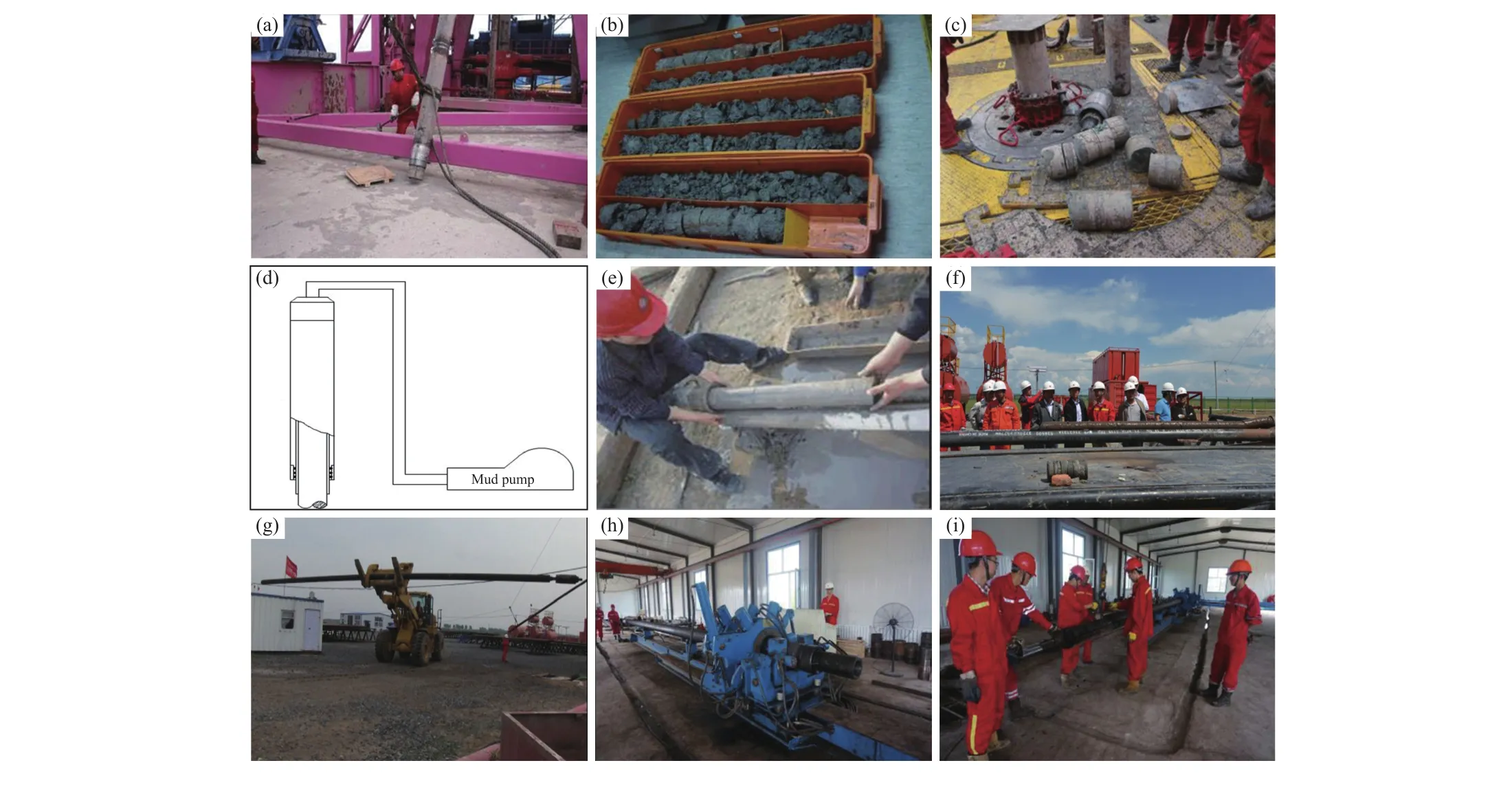
Fig. 14. Methods for pulling cores and its core samples. (a). The normal methods for pulling cores from the barrel. (b). The loose cores drilled from SK-I. (c). The hard cores drilled from SK-II. (d). Mechanism of pulling cores by water. (e) Using water to pull cores in SK-I. (f) Large scale of using water to pull cores in SK-II. Cores pushed out of barrel by machine. (g). The core barrel filled with cores is being carried to operating room; (h). The hydraulic disassembly and mounting bracket used for pushing hard core; (i). The φ214 mm diameter cores are being pushed out of core barrel by the hydraulic disassembly and mounting bracket.
4. Conclusions
(1) The large-diameter same-diameter coring, a technical innovation that realizes the concept of “coring in the same diameter, drilling completion in one diameter” for scientific drilling, simplifies the drilling procedures for large-diameter coring sections and avoid procedures to ream and lift/set down moving casing as well as downhole risks. The core volumes drilled in the φ311 mm and φ216 mm sections are 5.07 times and 1.70 times than that of those geologically required, providing more valuable core materials for geoscientific research; successful application of the longroundtrip-process coring method effectively reduces the roundtrip meter footage drill hours in the deep well sections,thus increasing the overall drilling efficiency in the deep well sections greatly. The “l(fā)arge-diameter diamond long-process same-diameter core drilling system” which combines both methods shortening the construction durations for the 3rd and 4th spud-ins of Songke Well No.2 by at least 6 months and saving the drilling cost over RMB 30000000. The innovative drilling method will certainly give positive impact to the drilling of deep and ultra-deep wells for the purpose of science and resources, and provide reference and guidance for their design, construction and budget.
(2) for the 4th spud-in, the polysulfonate mud system and the polymer mud system used work well at the downhole temperature 188°C (measured in the depth 5982 m at 28 h after the circulation stops); for the 5th spud-in, the formula polymer mud system prepared with the independently developed ultrahigh-temperature stabilizer works well at the downhole temperature 241°C (measured in the depth 7018 m at 38 h after the circulation stops). For both spud-ins, no accident of drill bit was being stuck or buried due to falling lumps and collapse happens, and after drilling is completed for the spud-in, casings are set down at one go before logging and cementation. For the 5th spud-in, after 30 d of drilling stoppage for cementation, the drill stem passed through the 100 m open-hole section and reached the downhole, the pump is started to circulate mud without abnormal pump pressure,and the completion fluid is replaced successfully. This suggests that after 30 d geo-temperature recovery from 241°C in the downhole, mud does not deteriorate and fail, there is no excessive barite precipitate in the downhole, the wall remains stable and mud can continue working at the temperature higher than 241°C. During the 5th spud-in, the ultrahightemperature mud system resistant to 250°C is successfully developed, and resultantly the recorded highest working temperature of water-based mud exceeds the critical point 240°C in China, the first time, providing a basic guarantee for Songke Well No.2 to be safely completed in the depth 7018 m.
(3) Discharging bid rough cores out of core tubes in the intact form on the ground is one of the important steps to provide high-quality core materials from scientific drilling.The method “mechanical core discharge” developed for Songke Well No.2 solves the problem of core discharge in the intact form encountered in the case that the tube is severely blocked by hard and crushed cores and provides nearly 3600 m intact cores for geoscientific research, showing its very realistic geological implications. Considering stratum change,the method, in combination with previously developed"hydraulic core discharge", is able to solve problems concerning intact discharge of big rough cores drilled from various complex strata and deserves wide application in scientific drilling projects and sophisticated geoscientific researches.
(4) Songke Well No.2 creates the maximal well depth in continental scientific drilling in Asia, breaks four world drilling records, and demonstrates the overall drilling strength of China in the world and raises China’s international standing in drilling level.
Acknowledgement
Sun Jian-hua, Fan La-sheng, Liang Jian, Zhu Zhi-tong,Wang Yue-wei, Huang Yu-ming, Du Yao-sen, Long Dong,Xiao Zhi-qiang, Yu Jun-xun, Qi Liqiang etc, of Institute for Exploration Techniques and Institute for Prospecting Techniques, participated in site management and technical works of the drilling project; Wu Di, Zhu Xu-ming, Lin Penghao and Xu Lan-bo etc. graduates of China University of Geological Sciences (Wuhan), participated in mud experiments and technical works in the field; the editor-inchief Hao Zi-guo, executive editor-in-chief Yang Yan of China Geology, and expert reviewers worked industriously on this paper. Hereby thank all of them.
- China Geology的其它文章
- New discovery of the permafrost gas hydrate accumulation in Qilian Mountain, China
- New delineation of two favorable zones for gas hydrate in southern Qinghai and northern Tibet, China
- Introduction of the International Research Centre on Global-Scale Geochemistry under the auspice of UNESCO
- Progress in China’s geological exploration in the first half year of 2018
- Discovery of the largest Carboniferous manganese deposit in Longtou-Limiao, central Guangxi, China
- Discovery of the pegmatite lithium veins with predicted super-large size resources in the Sizemuzu district of the Keeryin, China

